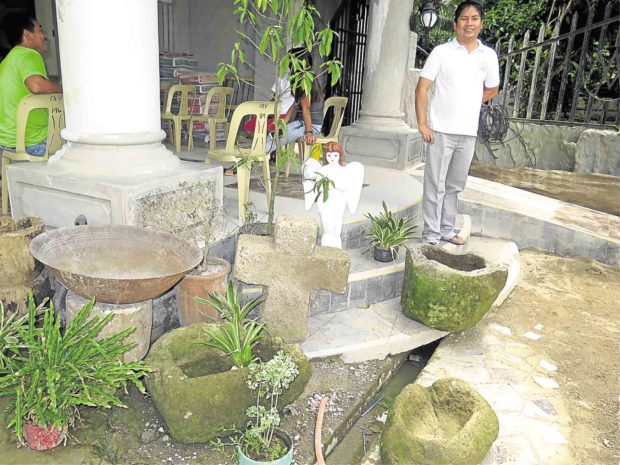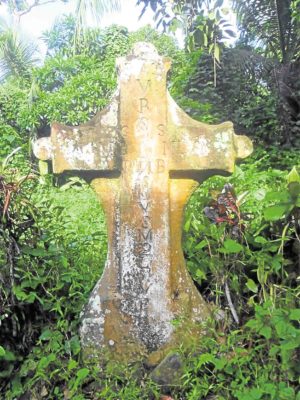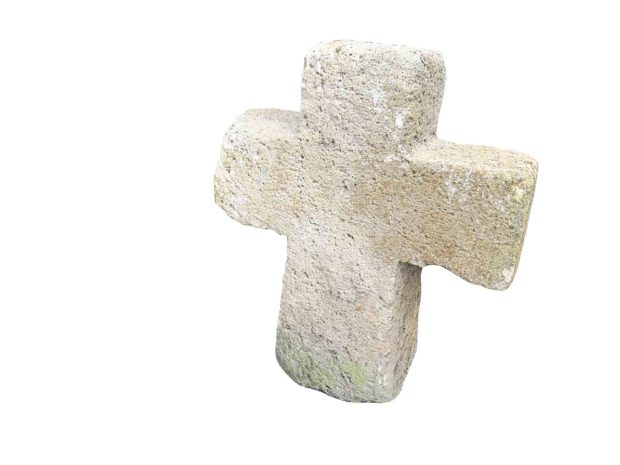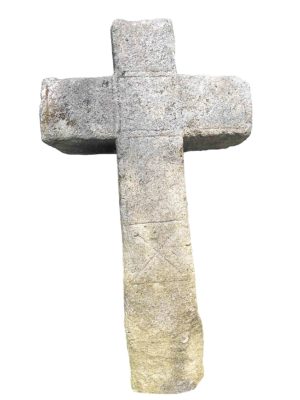The strange stone crosses of Tayabas

Fr. Jason Oriasel shows a stone cross among garden ornaments. Stone crosses, in varying designs, are found around Tayabas, a city nestled at the foot of Mount Banahaw in Quezon province. —PHOTOS BY DELFIN T. MALLARI JR. AND JOHN VALDEAVILLA
TAYABAS CITY — Nothing appears to be peculiar about Vilma Lubiano’s two-story, wood-and-concrete house fenced by flowering plants inside the coconut farm in Tayabas City, but for the ancient stone cross jutting in the backyard, now coated with moss and patched up with concrete to prevent more cracks.
It has always been with the family, Lubiano, 46, a councilor of Barangay Lakawa, says of the cross measuring a foot wide and one-and-a-half-foot high.
Another village leader, Francisco Lavadia, 50, says his family owns a larger cross, measuring 2 feet wide, 2 feet 4 inches tall, and four-and-a-half inches thick. It was originally displayed at the chapel in Barangay Ilayang Alsam.
“Some believe that a cache of treasures was buried around the perimeter of the cross,” Lavadia says, “but no one dared to search for it.”
Spanish-era stone crosses, measuring from a few inches to 2 meters, are found in remote forested areas in the shadow of mystical Mount Banahaw in Tayabas, a throwback to the time when it was established in 1578 by two Franciscan missionaries.
Article continues after this advertisementFrom 1779 to 1910, Tayabas was the capital town of the province, also called Tayabas, but now known as Quezon.
Article continues after this advertisementDeteriorating
To this day, the manmade crosses still stand but in varying degrees of deterioration from decades of exposure to the elements. These are also preyed upon by antique collectors, treasure hunters and speculators.
Raymundo Andres Palad, a local historian and national president of the Kapisanan ng mga Bahay Saliksikan sa Bansa (Association of Study Centers), says the stone crosses are “unique” in Tayabas. “No other discoveries like these are found in other parts of the country,” he says.
In his book, “Bayan ng Tayabas: Kasaysayan at Kalinangan (1575-1985),” Palad describes the old stone crosses as made up of “volcanic lava deposits of andesitic composition.” Some bear Latin inscriptions and strange characters.
In 2003, he wrote, archeological surveys on the “kagamitang bato” (stone works), including 10 stone crosses, were conducted by the University of the Philippines (UP) Archaeological Studies Program, National Institute of Geological Sciences and UP Vargas Museum.
There may be more remaining, says John Valdeavilla, a local heritage protection advocate. “I’ve already seen at least 12 of them,” he says.
Unknown origin
How the crosses came about, when they were made and how they ended up in the possession of local families are still unknown, Palad says.
He can only cite general accounts — that those built in remote areas were probably meant to protect against evil spirits, such as “aswang,” “kapre” or “maligno,” as what those living in “linang” (farmland) believe.
Jayeel Serrano Cornelio reported in “Religious Rituals in Tayabas” in 2009, that the cross, especially in its stone form, “seems to be an extension of the pre-Hispanic worship of stone as they were believed to be inhabited by spirits.”
Some people still call them “buhay na bato” (living stone) to this day, Cornelio says.
Palad says the stone crosses may also have been influenced by the “cruceiro” in Galicia region in Spain, where concrete religious images are found at random along the road to guide and protect pilgrims going to the sacred burial ground of Saint Santiago Apostol of Galicia.
“This needs further study to find out if there had been friars from Galicia or Spanish migrants from the same region who settled in Tayabas,” he says.
Spanish friar rule
Palad says the stone crosses may have also symbolized submission of its original owners to friars.
Fr. Jason Oriasel, parish priest of Our Lady of the Visitation church in Barangay Ibabang Palale, theorizes that the size of the ancient stone crosses reflects the social standing of its original owners.
“If it’s big, the owner is a prominent clan,” says Oriasel, a native of the village who also conducts study and collects ancient stone crosses and other stone works for his church.
According to him, the forested areas where some old stone crosses are found used to be upland communities of Tayabas’ forebears. “Some China wares, household tools were discovered in those places,” he says.
Palad has been campaigning that the vintage artifacts be declared “national cultural treasures.” He has been prodding the local government to act for their protection and preservation, as well as to conduct exhaustive studies and full documentation of the remaining stone crosses.
The National Cultural Heritage Act of 2009 (Republic Act No. 10066) defines a national cultural treasure as “a unique cultural property found locally, possessing outstanding historical, cultural, artistic and/or scientific value which is highly significant and important to the country and nation, and officially declared as such by pertinent cultural agency.”
Preservation funds
By declaring the structure’s heritage value, the government is obliged to provide funds to maintain and preserve it.
Palad laments that some small stone crosses have been sold by their owners or uprooted. He describes them as “busong” or disrespectful.
“Hopefully, the giant crosses will be spared from being stolen or sold,” he says.
Several antique collectors want to buy the stone crosses for P5,000 apiece, Lavadia reveals. Some buyers, he says, want to crack open the figures on the belief that these contain treasures.
“It’s not for sale. It’s a family treasure,” he says.
It was learned that a former town official bought some of the crosses for his collection.
Documentation work
Tayabas Councilor Precy Glorioso says she will sponsor a resolution for the creation of a workforce or office in the municipal government to study and initiate protection and preservation programs for local cultural treasures, including archaic stone crosses.
“We are blessed with rich heritage treasures. It is our duty to protect and preserve them for future generation,” Glorioso says.
The local government, she says, has already initiated efforts to protect their heritage treasures. She cites the formation last year of “Oplan Sagip Tulay” by some municipal employees to preserve the town’s Spanish-era arch bridges.
The century-old stone crosses, according to Palad and Oriasel, have long been part of Tayabas’ “Santakrusan” rites in May.
Instead of holding a religious procession with local beauties and escorts, some residents make the rounds of several houses to pray, sing ancient religious verses and offer flowers before the crosses or their images.
“According to family history, the cross was built by our ancestors. That’s why we’re taking care of it,” Lubiano says.




